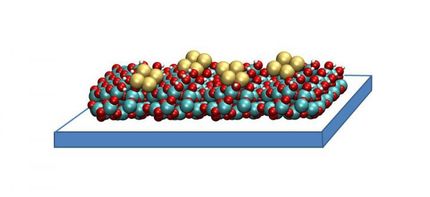Researcher at University of Basque Country devises fuel that are more efficient cells, thanks to a new catalyst
Advertisement
Methanol fuel cells are an efficient and sustainable alternative to fossil fuels, but they are still not economically viable Nevertheless, for his PhD, University of the Basque Country (UPV/EHU) research chemist, José E. Barranco, has developed new materials that enable the manufacture of cheaper and more efficient methanol fuel cells.
For fuel cells to be a competitive option amongst alternative energies, advances in a number of fields are required, amongst these being the development of new catalysts. It is in here that José E. Barranco's focused when he presented his PhD thesis, Development of new metallic materials of an amorphous nature for use in direct methanol fuel cells, at the UPV/EHU. José Enrique Barranco Riveros is a graduate in Chemical Sciences and is currently working as a researcher employed by the Polytechnic University School in the Basque city of Donostia-San Sebastián. His PhD was awarded excellent cum laude unanimously and was led by Dr. Ángel Rodríguez Pierna of the Department of Chemical Engineering and the Environment at the University School. Methanol as an alternative
In order for the fuel cell to generate electricity, a chemical reaction called electro-oxidation has to take place and this, in turn, requires a catalyst to accelerate the process. This catalyst is inserted in the fuel cell membrane and, in the case of methanol, the basic accelerator is platinum, a scarce and expensive metal. This is why the aim of Dr. Barranco's thesis was to devise a catalyst composed of a metal alloy in which the amount of platinum is significantly reduced. His research focused on a fundamental problem: the electro-oxidation of methanol produces carbon monoxide, a molecule that adheres to the metal and inhibits the latter's catalysing capacity, i.e. it impedes the accelerator from doing its work and energy production is halted.
After investigating the composition of numerous metals, Dr. Barranco made alloys that enabled the reduction of the proportion of platinum to 1%. These alloys, composed of elements such as nickel, niobium, antimony or ruthenium, amongst others, have the unique property of converting molecules of carbon monoxide (CO) into carbon dioxide (CO2) efficiently. The CO2, being gaseous, does not adhere to the catalyst which in the long term favours the catalytic process.
This means that the methanol fuel cell will emit a small quantity of CO2 which, according to Dr. Barranco, is easily tolerable by nature given that this can be incorporated into the photosynthesis cycle of plants.
Once the suitable catalyst was found, Dr. Barranco set out to increase its efficiency. The conclusions of his PhD thesis point to the fact that, if the platinum alloy is structured amorphously, its electrical conduction properties are enhanced and it undergoes less corrosion (advantages for the medium in which it has to operate). Moreover, it has an operational capacity in the order of 80-100 times greater than platinum in a crystalline structure. Amorphous materials are those with a disordered molecular structure and which, in this case, are obtained by the sudden cooling of metal alloys.
Also, for the catalyst made on this basis of amorphous metal alloys to be incorporated into the fuel cell membrane, Dr. Barranco decided to change its form. The result is a very fine powder that is placed in a container to "spray paint" the membrane. Not only this: as it is a substance made of minute particles, the operating capacity of the catalyst is enhanced by 9 to 13 times.
Other news from the department science
Most read news
More news from our other portals
See the theme worlds for related content
Topic world Synthesis
Chemical synthesis is at the heart of modern chemistry and enables the targeted production of molecules with specific properties. By combining starting materials in defined reaction conditions, chemists can create a wide range of compounds, from simple molecules to complex active ingredients.

Topic world Synthesis
Chemical synthesis is at the heart of modern chemistry and enables the targeted production of molecules with specific properties. By combining starting materials in defined reaction conditions, chemists can create a wide range of compounds, from simple molecules to complex active ingredients.




























































